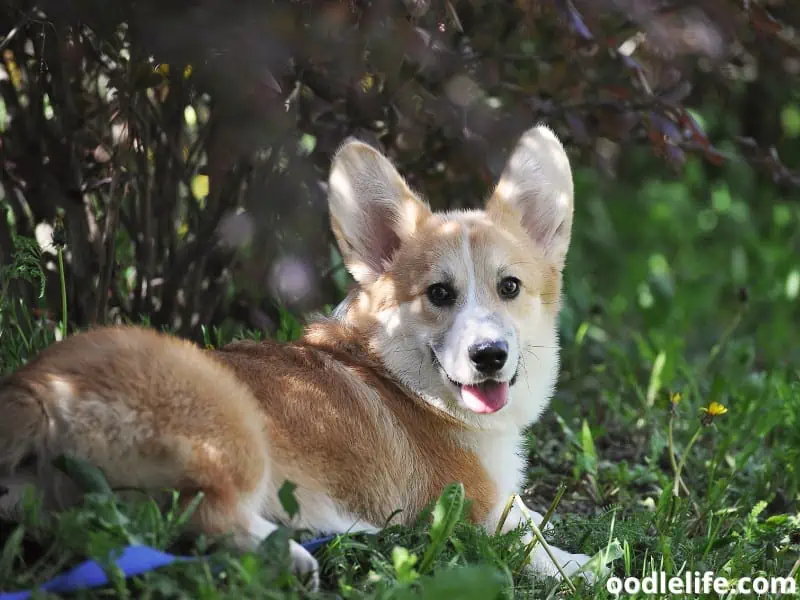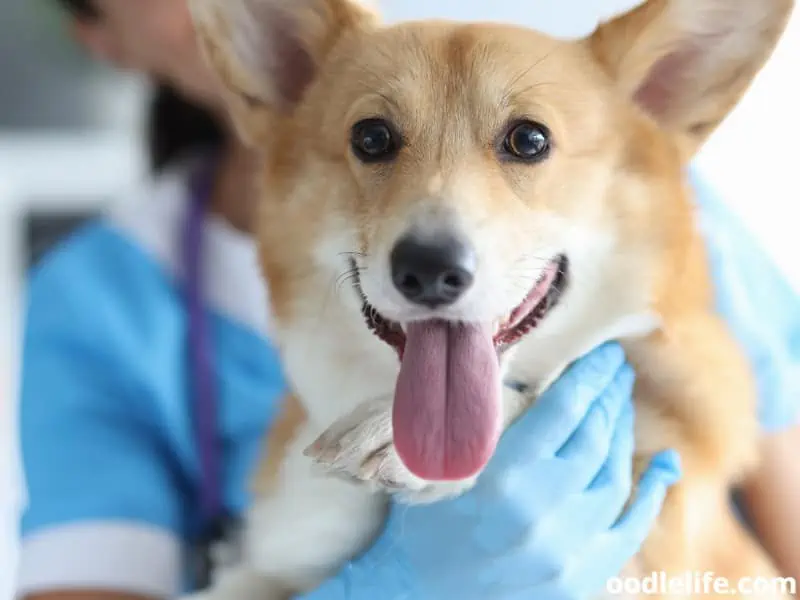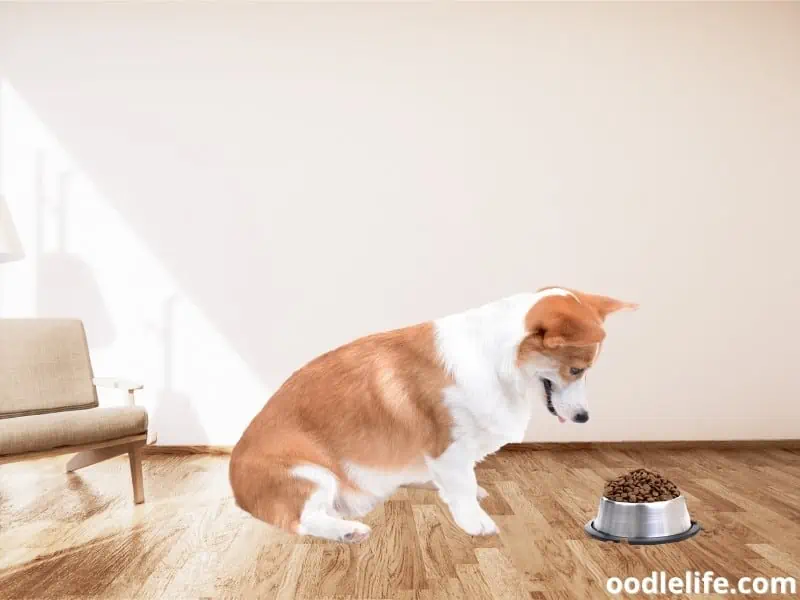When Do Corgis Go Into Heat?
Corgis, those adorable little dogs with big personalities, are loved by people all around the world for their unique appearance and friendly demeanor. If you’re a Corgi owner or considering adding one to your family, it’s essential to understand aspects of their reproductive cycle, such as when they go into heat. This knowledge will help you better care for your Corgi and ensure their health and well-being.
Female Corgis generally go into heat for the first time between the ages of 6 months and 1 year. The heat cycle, or estrus cycle, typically lasts around three weeks but can vary from one dog to another. During this time, you may notice several changes in your Corgi’s behavior, such as increased attention-seeking, restlessness, and possibly even a little sassiness.

It’s essential to keep an eye on your furry friend during this period, as she might be more likely to try and escape in search of a mate.
In addition to behavioral changes, you’ll also observe physical symptoms, including swelling of the vulva and bloody discharge. It’s important to remember that this is a natural process for your Corgi and, armed with the right information, you’ll be able to provide the necessary care and support during her heat cycle. By understanding your Corgi’s reproductive cycle, you can ensure a healthy and happy life for your four-legged companion.
Understanding Corgi Heat Cycle
Corgis, like other female dogs, go through a regular reproductive cycle called the estrus cycle or heat cycle. The heat cycle typically consists of four stages: proestrus, estrus, diestrus, and anestrus. To give you a better understanding of when Corgis go into heat, let’s go through each stage.

- Proestrus stage: This is the beginning of the heat cycle and lasts for about 9 days. During proestrus, a female Corgi may show signs like a swollen vulva and a bloody discharge. She might also urinate more frequently to mark her territory and attract males. However, she won’t be receptive to mating at this stage.
- Estrus stage: This is when a Corgi is ready for mating, and it generally lasts for 9 days as well. The vulva becomes even more swollen, and the discharge changes from bloody to more of a pinkish or clear color. During this stage, a female Corgi is receptive to male dogs and can get pregnant.
- Diestrus stage: This stage follows estrus and lasts around 60 days. If a Corgi becomes pregnant during the estrus stage, diestrus will bring about pregnancy and eventual birth. If she doesn’t get pregnant, her body will still act as though she is, and her hormones will return to normal after this stage.
- Anestrus stage: This is the “resting” stage of the heat cycle in which the female Corgi’s reproductive system resets itself. Anestrus typically lasts around 4 months.
So, how often do Corgis experience this heat cycle? Most female Corgis go into heat once every six months, although some may experience it more or less frequently. It is essential to note that Corgis can reach sexual maturity as early as six months of age, but it’s recommended to wait until they are at least 18 months old before breeding to ensure their health and the health of their puppies.
Now that you’ve got the basics, it’s time to break out that Corgi-calendar and keep an eye out for any signs to better understand your beloved canine companion. Remember, knowledge of your Corgi’s heat cycle is essential not only for breeding but also for general health and well-being.
Signs of a Corgi in Heat
Corgis, like other dogs, experience heat cycles throughout their lives. When a female Corgi is in heat, there will be some physical and behavioral changes that can indicate her readiness to mate. As an owner or a Corgi lover, it is essential to recognize these signs to manage your dog’s wellbeing.

One of the first noticeable signs is swelling of the vulva. The Corgi’s vulva becomes enlarged, and sometimes, spots of blood may appear. During this time, it is common for a female Corgi to experience increased urination.
Frequent urination serves as a signal to attract male dogs, and you might find a few male suitors in the vicinity.
Behavioral changes in a Corgi during heat can include restlessness and mild aggression. A normally docile Corgi may become slightly more aggressive as her hormones fluctuate. She may become more protective of her environment and might start to demonstrate mounting behavior, even towards inanimate objects.
Some owners prefer using dog diapers to prevent spotting and maintain hygiene. Dog diapers can also assist in keeping the unwanted attention of male dogs at bay, so if you’re a cautious Corgi caretaker, this option is worth considering.
Physical maturity plays a huge part in when a Corgi goes into heat. Female Corgis usually have their first heat cycle between 6 and 9 months, although it may vary. Keep a close eye on your female Corgi during this time, as the start of her heat cycle can sometimes be subtle.
In summary, signs of a Corgi in heat include swelling of the vulva, spots of blood, increased urination, frequent urination, and behavioral changes like restlessness and aggression. Taking proper care of your Corgi during her heat cycle ensures her wellbeing, so be attentive and prepared. And remember, the best way to avoid a convoy of smitten male dogs at your door is simply to stay well-informed and vigilant.
Caring for a Corgi in Heat
Caring for a Corgi in heat can be challenging, but it’s essential to understand their needs to ensure their well-being during the heat cycle. First, it’s important to recognize the signs of your Corgi entering their estrous cycle. They may start to show an increase in urination, swelling of the vulva, and some discharge.

Don’t fret; these are all natural occurrences.
Providing a clean environment is crucial during this time. Pay attention to their sleeping areas and make sure to change blankets or bedding frequently. If you notice discharge, you can use dog diapers to help keep things tidy.
In addition, keeping their living area clean can prevent potential bacterial infections and keep your furry friend comfortable.
During the heat cycle, your Corgi may have an increase in appetite and water intake. Be sure to provide plenty of fresh water and adjust their meal portions accordingly. However, remember not to overfeed them, as obesity can harm their health and exacerbate issues like hip dysplasia.
Your Corgi may also require more love and affection during this time! Extra cuddles can help them feel secure and comfortable. Be mindful that your Corgi may attempt to mate with other dogs, so ensure they are supervised during walks and interactions.
You might want to consider using a leash, even in enclosed areas, to keep them out of trouble.
Bathing your Corgi during this period should be avoided, as it can disrupt the natural oils on their skin. If necessary, you can gently wipe their vulva with a damp cloth to clean any discharge. Regularly monitor their vulva for signs of infection, such as redness or swelling, and consult a veterinarian if needed.
Lastly, if you don’t plan to breed your Corgi, consider spaying them to avoid the heat cycle entirely. Spaying has numerous health benefits, including reducing the risk of diseases like mammary cancer and uterine infections. After the procedure, your Corgi will need proper care during their surgical recovery, such as wearing a recovery suit and having a safe space to rest.
In conclusion, caring for a Corgi in heat may require extra attention, but with some patience and understanding, you can help your four-legged companion stay comfortable and healthy during this time.
Corgi Breeding Considerations
As a Pembroke Welsh Corgi owner or breeder, understanding the heat cycle and breeding timing is essential. Female Corgis typically experience their first heat or estrus when they are 6 to 9 months old. However, waiting until the second heat is often recommended for breeding to ensure proper growth and maturity.

During the heat cycle, female Corgis might become more affectionate and have an increased appetite. Keep an eye on the dog’s temperature, as a drop of about one degree can indicate ovulation. This is a crucial time for breeding, as a female’s ovaries release eggs, and fertilization can occur.
Breeding during the optimum time helps ensure a successful pregnancy. The gestation period for Corgis lasts around 63 days, after which you’ll welcome a litter of adorable puppies. When planning a breeding session, coordinating with a reputable breeder can be beneficial, as they can provide valuable insights into the process.
It’s essential to maintain a healthy living environment for both male and female Corgis during the breeding process. Ensuring proper diet, exercise, and reducing stress are all critical factors in promoting frequent and successful breeding.
While breeding Corgis can be a rewarding endeavor, it’s important to keep the health of the dog in mind. Overbreeding can affect a female Corgi’s overall well-being, so it’s essential to consult with a veterinarian to ensure the dog is in good health before breeding repeatedly. Likewise, if you don’t plan to breed your Corgi, you may consider spaying or neutering to avoid unwanted pregnancies and health complications related to hormonal changes.
In conclusion, understanding the heat cycle, timing, and overall health of your Pembroke Welsh Corgi is vital for successful breeding. Teaming up with an experienced breeder and consulting with a veterinarian can ensure the happiness and well-being of all parties involved, particularly the feisty little Corgis themselves. Happy breeding!
Spaying and Neutering
Spaying and neutering your Corgi is an important decision for both you and your furry friend. Not only does it help control the pet population, but it can also benefit your Corgi’s health in various ways.

Female Corgis experience their first heat cycle typically between 6 and 10 months of age. Spaying, the removal of ovaries and uterus, can help prevent health issues such as estrogen-related diseases and unwanted pregnancies. Spayed females are also less likely to experience urinary incontinence.
On the other hand, neutering a male Corgi involves removing the testicles, which can prevent testosterone-driven behaviors and reduce the risk of certain health issues like prostate problems and testicular cancer.
While spaying or neutering your Corgi has its benefits, it is essential to consider the right time to perform these procedures. A recent study suggests that the best time to neuter your pup may be between 18 and 24 months. It helps in avoiding potential issues related to abnormal bone growth and bone cancer.
When your Corgi goes into heat, you might notice changes such as a change in appetite and lethargy. It’s crucial to keep an eye on these signs to ensure your dog’s well-being during this period.
A fun fact about Corgis that you might not know is that they come in two distinct flavors (in terms of breed, of course): Pembroke Welsh and Cardigan Welsh. So, whether you prefer the “classic” look with a docked tail or the “au naturel” appeal of a fluffy tail, there’s a Corgi out there waiting for you!
To sum it up, spaying and neutering can benefit your Corgi’s health in several ways. Make sure to consult with your veterinarian to determine the best course of action for your pet. And remember, a happy Corgi means a happy home!
Common Health Issues in Corgis
Corgis are generally healthy dogs, but like any breed, they can have their share of health issues. One of the most common health issues in Corgis is hip dysplasia, a genetic condition that affects the hip joints and can cause pain and mobility problems. Fortunately, with proper care and regular check-ups, many Corgis can live fulfilling lives with this condition.

On another note, female Corgis typically go into heat for the first time between 9-11 months of age. It’s essential to pay attention during this time to ensure the well-being of your Corgi. Their heat cycles usually occur every 6 months and can be accompanied by increased urination and a swollen vulva.
Corgis are known to have issues with their teeth, and dental infections can occur without proper care. Regular brushing and dental cleanings can help keep their teeth in good shape and prevent problems down the line.
While these health issues might sound concerning, don’t let it stop you from enjoying the companionship of a Corgi. They are confident, energetic dogs with a lot of love to give. Remember to give them the right care and maintain regular vet check-ups to ensure your furry friend stays happy and healthy for years to come.
Now, you’re well-equipped with the knowledge to better understand and care for your Corgi, so go forth and shower them with the love and attention they deserve!
Additional Tips for Corgi Owners
As a Corgi owner, you may be wondering when exactly your furry friend will go into heat and what you can expect during that time. Fear not, fellow pet parent, we’ve got you covered with some helpful pointers.

First and foremost, it’s important to understand the Corgi heat cycle. A Corgi typically goes into heat every six months, starting between the ages of 6-18 months. You’ll want to keep an eye out for signs such as a beautiful (well, for your Corgi anyway) blood-tinged discharge, which indicates the onset of the heat cycle.
When your Corgi goes into heat, you might notice some personality changes, like a sudden fondness for clicking her nails across the floor. Now is the perfect time to work on that long-overdue grooming. As a pet owner, it’s essential to trim your Corgi’s nails and keep them groomed for the sake of your home and your sanity.
Who knew spots of blood could make such a mess?
In addition to grooming, you also want to pay extra attention to your Corgi’s diet during this time. A delicious, well-balanced meal is always appreciated, especially during the heat cycle. Keeping your Corgi well-fed with a nutritious and appropriately portioned food will ensure she stays happy and healthy throughout the process.
Remember, fellow pet parents, keeping a keen eye on changes in your Corgi’s behavior and appearance, as well as regular grooming and a proper diet, will help you and your pooch navigate the heat cycle with ease. Armed with this knowledge, you can confidently tackle heat cycles like a Corgi tackles a frisbee – head on, with boundless enthusiasm.